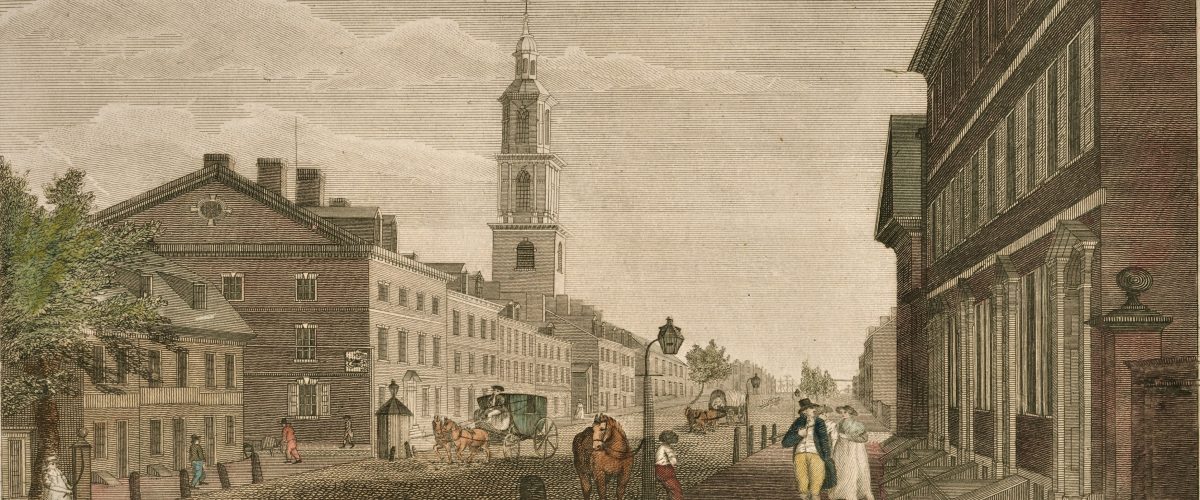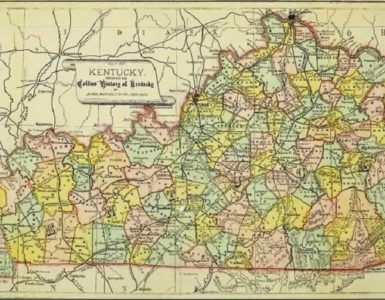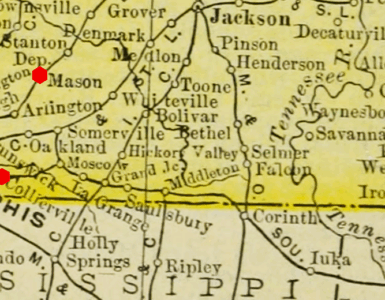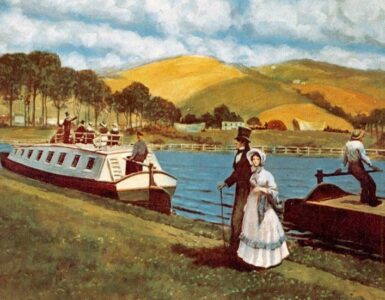 Jacob Jones was born in New York, November 20, 1774, to George and Effie (Ten Eyck) Janeway. The family were members of the Reformed Dutch Church. The Dutch established a colony in 1609 a portion of which included what is currently eastern New York. The colony was named New Nederland and the city New Amsterdam. In 1664 when the Dutch naval fleet was defeated, the colony was relinquished to the victors, Great Britain, resulting in renaming the state and city New York after the Duke of York. The Dutch and American Presbyterian Church enjoyed a close relationship in the city. The marriage of English American Janeway to Dutch American Ten Eyck provides a picture of the Calvinist harmony between the denominations. During the Revolutionary War the Janeways fled to New Jersey because of assaults by British troops and periods of occupation. When the Janeways returned to the city after the war, Jacob continued studies with his vocational interest inclined toward medicine, but then the Lord brought the ministry to mind. He consulted his pastor about the future and was advised to have a day of prayer and fasting to seek the will of God regarding his calling. Jacob followed the wise advice and his call to the ministry was confirmed. At this time, likely at the age of thirteen, he wrote a covenant with God that he signed and sealed testifying to his commitment to enter the gospel ministry.
Jacob Jones was born in New York, November 20, 1774, to George and Effie (Ten Eyck) Janeway. The family were members of the Reformed Dutch Church. The Dutch established a colony in 1609 a portion of which included what is currently eastern New York. The colony was named New Nederland and the city New Amsterdam. In 1664 when the Dutch naval fleet was defeated, the colony was relinquished to the victors, Great Britain, resulting in renaming the state and city New York after the Duke of York. The Dutch and American Presbyterian Church enjoyed a close relationship in the city. The marriage of English American Janeway to Dutch American Ten Eyck provides a picture of the Calvinist harmony between the denominations. During the Revolutionary War the Janeways fled to New Jersey because of assaults by British troops and periods of occupation. When the Janeways returned to the city after the war, Jacob continued studies with his vocational interest inclined toward medicine, but then the Lord brought the ministry to mind. He consulted his pastor about the future and was advised to have a day of prayer and fasting to seek the will of God regarding his calling. Jacob followed the wise advice and his call to the ministry was confirmed. At this time, likely at the age of thirteen, he wrote a covenant with God that he signed and sealed testifying to his commitment to enter the gospel ministry.
As he matured Jacob’s preparation included the fundamentals with mathematics and science of particular interest, however Latin and Greek were a substantial part of the curriculum and he excelled in these as well as other languages. He entered Columbia College (University) at the age of fifteen, which is young by modern standards but it was not uncommon for the era. Janeway studied diligently late into the nights leading to a weakened constitution yielding repeated illnesses that would continue to plague him including heart trouble, respiratory affliction, and melancholia (depression). After graduation at the age of nineteen in 1794, he was taken under the wing of the father of the Reformed Dutch Church in America, John Henry Livingston. Under Livingston’s direction Jacob learned Hebrew and doctrine while observing applied theology in the ministry of his mentor. His persistence in studies was blessed when the road to ordination began with licensure by the Reformed Dutch Classis of New York, November 30, 1797. Janeway commented
This day I have spent in fasting and prayer to the throne of grace.…My covenant with Jehovah was renewed. (Memoir, 17)
During this time he remained at home with occasional excursions to preach in near-by churches and he made a lengthy missionary trip on horseback through New England with Reformed Dutch minister J. N. Abeel. However, his pastoral call would not be with the Dutch church of his youth.
The church that gave him a call was located in Philadelphia. Pastor Abeel was a friend of the minster at Second Presbyterian Church, Ashbel Green. Green graduated the College of New Jersey (Princeton) and had been at Second since 1787. He had been in the army during the fight for independence and was then chaplain to Congress for eight years. Second church was established with converts from the revivals of George Whitefield that brought many to Christ. The church was located at Third and Arch Streets and enjoyed hosting the First General Assembly of the Presbyterian Church in 1789. It was a golden opportunity for young Janeway to begin ministry with one of the most experienced shepherds of the denomination. The call letter transcribed here is as published in Janeway’s Memoir. Notice the date the call was issued.
Philadelphia, June 2, 1797.
My Dear Sir:
I have great pleasure in informing you that I have just returned from a meeting of the congregation which I serve, and at which you were elected my colleague, without a dissenting voice. The event has been the subject of my hopes and prayers for several months past, and I cannot easily express the gratitude I feel to God in having disposed the minds of his people to act with such unanimity on so important an occasion; and I do most earnestly pray that it may be a token for good. And now, my dear young friend, it remains with you to determine what answer you will return to the call of God’s people. As I trust he has inclined their hearts to you, I hope he may incline you to them. You cannot need the assurance from me that your acceptance of this call will afford me the most sincere and heartfelt pleasure. Now if you do accept it, my most ardent wishes will be gratified, so you may rely on every exertion in my power to render your situation here comfortable to yourself, and profitable to my dear people. I do not know that an individual of the congregation has a sentiment unfavorable to you. In a word, the congregation are as much united, and at peace among themselves, as any you will ever find; and this is certainly a consideration of much importance, and one that ought to have great weight with you, in the determination you are to form. May God be with you and direct you.
Most affectionately yours,
Ashbel Green
It is a simple call when compared to those issued today—the congregation desires your capable ministry and is united in peace anticipating your acceptance. Unfortunately, Janeway could not be ordained and installed for two years because occurrences of Yellow Fever in the region delayed the Presbytery of Philadelphia’s service until June 13, 1799. Janeway was ordained during the same service as John Blair Linn and Buckley Carl, along with William and John E. Latta (sons of James Latta). Janeway and Green continued in co-ministry for thirteen years until Green resigned to become president of the College of New Jersey. To assist Janeway, as he himself had assisted Green, a new minister named Thomas Skinner was called. However, Skinner increasingly came under the influence of the New England Theology and was vocal about his views leading to division within the congregation. For about two years the conflict distressed Janeway because he held a firm commitment to the Westminster Standards but was concerned not only for the purity but the peace of his flock. Janeway tried to resolve things, but the solution unfortunately came through division when Skinner and about forty members left to establish a new congregation. With the division of the Presbyterians into Old School and New School in 1837, Janeway became a leader of the former, and Skinner and his congregation found their home in the latter. During his Second Church years Janeway edited The Presbyterian Magazine (1821-1822) and contributed many of the articles. He was also the Stated Clerk of the General Assembly for nine years before becoming moderator for 1818.
With the nation expanding west, theological education opportunities for ministers needed to be provided in the newly settled areas. In 1827, the moderator of the General Assembly was Francis Herron, minister of First Church, Pittsburgh. After considerable debate by the commissioners about the location including appeals from the moderator (out of order today?), the site selected for Western Theological Seminary was Allegheny just across the rivers west of Pittsburgh. Janeway was selected to be the first professor, declined initially, but then accepted. His son Thomas went with him to teach Hebrew. The seminary had already started classes with Dr. Elisha Pope Smith instructing. Janeway was installed October 17, 1828. Pittsburgh and Allegheny are situated at trois rivières and had become a hub for river traffic. The cities also were important for manufacturing flatboats and associated supplies for river navigation. The reasons why Janeway submitted his resignation to the General Assembly in 1829 after less than a year included disappointment with the property and the few students attending the seminary. Janeway felt he had been misled about the prospects for the new seminary. Walther observed that “Mrs. Janeway preferred the more sophisticated lifestyle of Philadelphia” (136) and it is likely Dr. Janeway did too. He had struggled making the decision to change call, but his Memoir records his confidence in providence.
I feel satisfied with having done my duty, both in accepting my office, and now in resigning it. Blessed be God! All things, I trust, will work together for my good. I closed my exercises by renewing my covenant, and asking the forgiveness of imperfections. (234)
As Janeway remembered his covenant made with God so many years before, he was confident a new call would be provided based on the Lord’s previous faithfulness.
The Janeways moved back to Philadelphia where he supplied churches and worked with the committees of the Presbyterian Church and parachurch organizations while seeking a new call. Earlier in his ministry Jacob was offered a call by the First Reformed Dutch Church, New Brunswick, New Jersey, that he had turned down, but the church was interested again and issued a call, which he accepted. First Reformed dated to the early seventeenth century and its first congregation included both Dutch and French Reformed (Huguenot) Christians. He was installed May 26, 1830. Steele notes that the “church now felt that they had secured a pastor of middle age, who would long remain among them, and give his ripe experience and sound instruction to the upbuilding and establishment of the congregation,” however Janeway’s reoccurring bouts with illness and melancholia limited his ministry (124-25). His problems were exacerbated by the size of the congregation that was distributed over a large area necessitating much travel for pastoral visitation and catechesis. The New Brunswick community had high expectations for his civic involvement because of the size of First Reformed and his prominence serving such a large church. Janeway thought new churches needed to be established with their own pastors and he believed community duties came well after congregational ones. The classis (similar to a presbytery) granted him dissolution of his call February 24, 1831 after only nine months of ministry. Two short-term ministries ended abruptly, but Janeway stuck to his covenant with God.
In 1833, after a move to New York and a time supplying pulpits, Dr. Janeway was elected by the General Synod of the Reformed Dutch Church to become Vice-President of Rutgers College, and Professor of Belles-Lettres and the Evidences of Christianity. The call was accepted, and the move was made to New Brunswick. When Philip Milledoler resigned from the presidency of Rutgers, it was offered to Janeway, but he refused. After the Western Seminary experience, he knew he did not want to be president of an academic institution. After six years, he resigned from Rutgers and left the Reformed Dutch Church to return to the Presbyterians.
Janeway’s last years were lived at a slower pace with his schedule limited. In 1848 his friend Ashbel Green, died and Janeway delivered the memorial sermon from Philippians 1:21, “To me to live is Christ, and to die is gain,” and then in 1850 his friend Samuel Miller died. Miller had written the introduction to Janeway’s, The Internal Evidence of the Holy Bible. When Janeway moved to Allegheny, the positions he held on boards at the College of New Jersey and Princeton Seminary were resigned, but with his return to the Presbyterian Church he was also returned to these boards. Janeway was on the board of Princeton Seminary 1813-1830, 1840-1858, and he held parallel tenures on the board of the College of New Jersey ending in 1858. He wrote and supplied pulpits while involved in the American Bible Society, the Presbyterian Committee on Foreign Missions, the Presbyterian Committee on Domestic Missions, and the American Board of Commissioners for Foreign Missions (A.B.C.F.M.). He was also active in editing and work for the Committee for Publications.
Jacob Jones Janeway, D.D., passed away on the Sabbath, June 27, 1858, having lived past eighty years and enjoying the blessing expressed in Psalm 90:10. His son notes that his father’s covenant written so many years ago was kept handy and he even wrote a note on it not long before he died. His Princeton friend and ministerial colleague Charles Hodge stood before the mourners gathered in First Presbyterian Church, New Brunswick to deliver the memorial. The sermon was from 2 Timothy 4:7-8. He described Janeway with propriety and personal knowledge of his dedicated life and ministry.
His remarkable placidity of temper, his amiable and courteous manners, his uniform regard for the feelings of others, carried him even through the severest conflicts without a scar. So far as we know, he never gave offence or made an enemy. His integrity was unimpeachable. He was truthful, frank, and honest. Always open in the expression of his convictions, no man was ever in doubt where he stood, or which side he occupied on any question of doctrine or policy. He was utterly incapable of chicanery or maneuvering. He never attempted to attain his objects by underhand measures. The end and the means were always openly announced and publicly avowed. As a preacher, Dr. Janeway was instructive, earnest, and faithful. As a pastor, he was indefatigable in his attention to the young, the sick, the afflicted and the inquiring. His zeal for sound doctrine was one of the most prominent traits of his character and had much to do in determining the whole course of his life. His zeal was not unenlightened bigotry but arose from the clear perception of the importance of truth to holiness. He was satisfied that the salvation of men and the glory of God were dependent on the preservation of the gospel in its purity. (279-80)
Janeway’s son provides some instances in Memoir when his father was not as “amiable and courteous” as Hodge says, but the general demeanor and presence of him is as Hodge described. During his life at times of particular blessing, sickness, difficulty determining God’s will, or special gratitutde, he fasted, prayed, and renewed his covenant with God. Jacob Jones Janeway, D.D., had lived a fruitful and beneficial life glorifying God and enjoying Him.
His wife Martha G. (Leiper), predeceased him in 1851. Their children included Thomas Leiper, George Jacob, Elizabeth Leiper, John Livingston, William Richard, and Henry Latimer Janeway. He was Stated Clerk of the General Assembly for ten years, 1807-1817. At Rutgers he was a trustee, 1830-1850, and in 1833 became Professor of the Evidences of Christianity, Professor of Political Economy, and the Vice President continuing to 1839. Middlebury College in Vermont honored Janeway with the Doctor of Divinity. Dr. Janeway wrote often and at great length, a list of his works is available on this site at “Bibliography, Jacob J. Janeway, 1774-1858” ; and Log College Press has a bibliography that provides downloads of many publications, “Jacob Jones Janeway.” Log College Press also has a nice reprint of Janeway’s Meditations on the Lord’s Supper.
Barry Waugh
Notes—The header is from the New York Public Library and it shows the Second Presbyterian Church looking down Arch Street in 1799; the portrait is courteous of Wayne Sparkman, PCA Historical Center. The use of “Reformed Dutch Church” rather than “Dutch Reformed Church” is consistent with the sources because it seems the former was used up to the early nineteenth century and the latter was the successor. Thomas Janeway published a biography of his father based on his diary, letters, and other documents, titled, Memoir of the Rev. Jacob J. Janeway, D.D., Philadelphia: Presbyterian Board of Publication, 1861; 322 pages. E. R. Beadle, The Old and the New, 1743-1876: The Second Presbyterian Church of Philadelphia, Its Beginning and Increase, Philadelphia: [Printed by J.B. Chandler], 1876. James Arthur Walther, Ever a Frontier: The Bicentennial History of the Pittsburgh Theological Seminary, Grand Rapids: William B. Eerdmans Publishing Company, 1994; this book provides history of the multiple institutions that came together into PTS and includes a diagram of its evolution. William P. White, Presbyterian Churches of Philadelphia: Their Organization and Changes of Location and Name, 1914; 24 page pamphlet. Minutes of the General Assembly of the Presbyterian Church in the United States of America from Its Organization A.D. 1789 to A.D. 1820 Inclusive, Philadelphia: Presbyterian Board of Publication, [1847.] Richard H. Steele, Historical Discourse Delivered at the Celebration of the One Hundred and Fiftieth Anniversary of the First Reformed Dutch Church, New Brunswick, N.J., October 1, 1867, New Brunswick: Published by the Consistory [similar to a session], 1867. George W. Winnans, First Presbyterian Church of Jamaica, New York, 1662-1943: A Narrative History Of Its Two Hundred and Eighty Years of Continuous Service, Published by the Church, 1943, 248 pages. Trustees, Faculty, Alumni and Students of Rutgers College (originally queen’s college), 1916; and Rutgers College: Founded as Queens College 1766, New Brunswick, New Jersey, Printed for the College, 1909; 36 pages. The children’s names are from Janeway’s Find a Grave entry; unfortunately, the Memoir does not include much family information.





